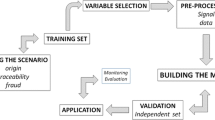Abstract
A common problem in food science concerns the assessment of the quality of food samples. Typically, a group of panellists is trained exhaustively on how to identify different quality indicators in order to provide absolute information, in the form of scores, for each given food sample. Unfortunately, this training is expensive and time-consuming. For this very reason, it is quite common to search for additional information provided by untrained panellists. However, untrained panellists usually provide relative information, in the form of rankings, for the food samples. In this paper, we discuss how both scores and rankings can be combined in order to improve the quality of the assessment.
Access this chapter
Tax calculation will be finalised at checkout
Purchases are for personal use only
Similar content being viewed by others
Notes
- 1.
The zero-one distance function is defined as \(d_0(s,s')=0\) if \(s=s'\) and \(d_0(s,s')=1\) otherwise.
- 2.
The \(\ell _1\)-distance function is defined as \(d_1(s,s')=|s-s'|\).
- 3.
The \(\ell _2\)-distance function is defined as \(d_2(s,s')=(s-s')^2\).
- 4.
When the rankings contain no ties, the Kemeny distance is equal to the double of the Kendall distance [9].
- 5.
Note that we write the word ‘distance’ between quotation marks since we are comparing objects of a different nature, and, thus, we are lacking the semantics associated with the mathematical formalization of a distance (metric).
References
Argyri, A.A., Doulgeraki, A.I., Blana, V.A., Panagou, E.Z., Nychas, G.J.E.: Potential of a simple HPLC-based approach for the identification of the spoilage status of minced beef stored at various temperatures and packaging systems. Int. J. Food Microbiol. 150(1), 25–33 (2011)
Argyri, A.A., Panagou, E.Z., Tarantilis, P.A., Polysiou, M., Nychas, G.J.E.: Rapid qualitative and quantitative detection of beef fillets spoilage based on Fourier transform infrared spectroscopy data and artificial neural networks. Sens. Actuators B: Chem. 145(1), 146–154 (2010)
Rogers, H.B., Brooks, J.C., Martin, J.N., Tittor, A., Miller, M.F., Brashears, M.M.: The impact of packaging system and temperature abuse on the shelf life characteristics of ground beef. Meat Sci. 97(1), 1–10 (2014)
Smolander, M., Hurme, E., Latva-Kala, K., Luoma, T., Alakomi, H.L., Ahvenainen, R.: Myoglobin-based indicators for the evaluation of freshness of unmarinated broiler cuts. Innov. Food Sci. Emerg. Technol. 3(3), 279–288 (2002)
Amerine, M.A., Pangborn, R.N., Poessler, E.B.: Principles of Sensory Evaluation of Food. Academic Press, New York (1965)
Sader, M., Pérez-fernández, R., Kuuliala, L., Devlieghere, F., De Baets, B.: A combined scoring and ranking approach for determining overall food quality (2018, submitted )
Franceschini, F., Galetto, M., Varetto, M.: Qualitative ordinal scales: the concept of ordinal range. Qual. Eng. 16(4), 515–524 (2004)
Kemeny, J.G.: Mathematics without numbers. Daedalus 88(4), 577–591 (1959)
Kendall, M.G.: A new measure of correlation. Biometrika 30(1–2), 81–93 (1938)
Acknowledgments
We gratefully acknowledge Innovation by Science and Technology (IWT) (now known as Flanders Innovation and Entrepreneurship (VLAIO)) for their support of the project CheckPack (IWT-SBO-130036) - Integrated optical sensors in food packaging to simultaneously detect early-spoilage and check package integrity. Raúl Pérez-Fernández is supported as a postdoc by the Research Foundation of Flanders (FWO17/PDO/160).
Author information
Authors and Affiliations
Corresponding author
Editor information
Editors and Affiliations
Rights and permissions
Copyright information
© 2018 Springer International Publishing AG, part of Springer Nature
About this paper
Cite this paper
Sader, M., Pérez-Fernández, R., De Baets, B. (2018). Combining Absolute and Relative Information in Studies on Food Quality. In: Medina, J., et al. Information Processing and Management of Uncertainty in Knowledge-Based Systems. Theory and Foundations. IPMU 2018. Communications in Computer and Information Science, vol 854. Springer, Cham. https://doi.org/10.1007/978-3-319-91476-3_32
Download citation
DOI: https://doi.org/10.1007/978-3-319-91476-3_32
Published:
Publisher Name: Springer, Cham
Print ISBN: 978-3-319-91475-6
Online ISBN: 978-3-319-91476-3
eBook Packages: Computer ScienceComputer Science (R0)





